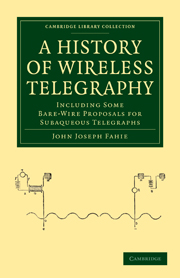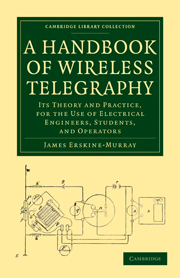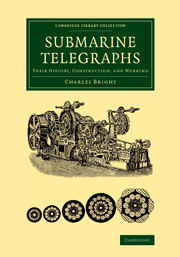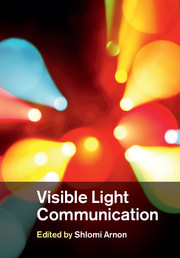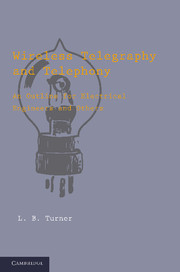A History of Wireless Telegraphy
John Joseph Fahie (1846–1934) was an engineer for the Electric and International Telegraph Company before being posted overseas in the Indo-European Government Telegraph Department. He was also a respected historian whose History of Wireless Telegraphy (1899) sold out two impressions in little over a year. In this second edition (1901), he traces the development of wireless communication during the nineteenth century, drawing extensively from the correspondence and technical illustrations of inventors themselves. This edition was fully updated to take account of the latest advances in radio technology, including Marconi's latest public demonstrations. As a practising telegraph engineer, Fahie was in the perfect position not only to understand the significance of these developments, but to explain them to a non-specialist audience. Contemporary reviews indicate he did this with great success. His book gives an eyewitness account of the rise of radio technology that still fascinates scholars and enthusiasts today.
Product details
May 2011Paperback
9781108026864
378 pages
216 × 140 × 21 mm
0.48kg
56 b/w illus.
Available
Table of Contents
- Preface to second edition
- Preface to first edition
- First Period – the Possible:
- 1. Professor C. A. Steinheil, 1838
- 2. Edward Davy, 1838
- 3. Professor Morse, 1842
- 4. James Bowman Lindsay, 1843
- 5. J. W. Wilkins, 1845
- 6. Dr. O'Shaughnessy, 1849
- 7. E. and H. Highton, 1852–1872
- 8. G. E. Dering, 1853
- 9. John Haworth, 1862
- 10. J. H. Mower, 1868
- 11. M. Bourbouze, 1870
- 12. Mahlon Loomis, 1872
- Second Period – the Practicable:
- 1. Preliminary. Notice of the telephone in relation to wireless telegraphy
- 2. Professor John Trowbridge, 1880
- 3. Professor Graham Bell, 1882
- 4. Professor A. E. Dolbear, 1882
- 5. T. A. Edison, 1885
- 6. W. F. Melhuish, 1890
- 7. Charles A. Stevenson, 1892
- 8. Professor Erich Rathenau, 1894
- Third Period – the Practical: Systems in actual use
- 1. Sir W. H. Preece's method
- 2. Willoughby Smith's method
- 3. G. Marconi's method
- Appendix A. The relation between electricity and light, before and after Hertz
- Appendix B. Prof. Henry on high tension electricity being confined to the surface of conducting bodies, with special reference to the proper construction of lightning-rods. On modern views with respect to the nature of electric currents
- Appendix C. Variations of conductivity under electrical influence
- Appendix D. Researches of Prof. D. E. Hughes, F. R. S., in electric waves and their application to wireless telegraphy, 1879–1886
- Appendix E. Reprint of G. Marconi's patent
- Index.

